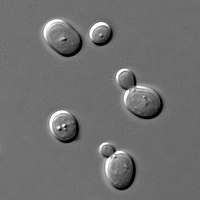
Novel glucoamylase-resistant gluco-oligosaccharides with adjacent α-1, 6 branches at the non-reducing end discovered in Japanese rice wine, sake.
Sign Up to like & getrecommendations! Published in 2021 at "Carbohydrate polymers"
DOI: 10.1016/j.carbpol.2020.116993
Abstract: Sake, a traditional Japanese rice wine, contains various oligosaccharides (Sake oligosaccharides; SAOs) derived from rice starch. We previously found that SAOs reach a high degree of polymerization (DP). In this study, we developed a hydrophilic… read more here.
Keywords: rice wine; rice; non reducing; branches non ... See more keywords

Optimized reducing-end labeling of cellulose nanocrystals: Implication for the structure of microfibril bundles in plant cell walls.
Sign Up to like & getrecommendations! Published in 2021 at "Carbohydrate polymers"
DOI: 10.1016/j.carbpol.2021.117618
Abstract: A strategy to optimize the labeling of the reducing end of native cellulose nanocrystals (CNCs) with gold nanoparticles (AuNPs) was developed and used to investigate the arrangement of the elementary crystallites constituting these biosourced particles.… read more here.
Keywords: cell walls; microfibril bundles; reducing end; cellulose nanocrystals ... See more keywords

Functionalisation of the non-reducing end of chitin by selective periodate oxidation: A new approach to form complex block polysaccharides and water-soluble chitin-based block polymers.
Sign Up to like & getrecommendations! Published in 2021 at "Carbohydrate polymers"
DOI: 10.1016/j.carbpol.2021.118193
Abstract: Most polysaccharides used in polysaccharide-based block copolymers are attached to the second block through the reducing end, due to the few and highly polysaccharide specific non-reducing end (NRE) functionalisation methods available. Chitin oligomers, prepared by… read more here.
Keywords: based block; block; non reducing; reducing end ... See more keywords

Identification of Mobility-Resolved N-Glycan Isomers
Sign Up to like & getrecommendations! Published in 2022 at "Analytical Chemistry"
DOI: 10.1021/acs.analchem.2c01181
Abstract: Glycan analysis has evolved considerably during the last decade. The advent of high-resolution ion-mobility spectrometry has enabled the separation of isomers with only the slightest of structural differences. However, the ability to separate such species… read more here.
Keywords: resolved glycan; mobility resolved; mobility; end anomers ... See more keywords

Synthesis and Characterization of Multi-Reducing-End Polysaccharides.
Sign Up to like & getrecommendations! Published in 2023 at "Biomacromolecules"
DOI: 10.1021/acs.biomac.3c00104
Abstract: Site-specific modification is a great challenge for polysaccharide scientists. Chemo- and regioselective modification of polysaccharide chains can provide many useful natural-based materials and help us illuminate fundamental structure-property relationships of polysaccharide derivatives. The hemiacetal reducing… read more here.
Keywords: polysaccharide; end polysaccharides; synthesis characterization; reducing end ... See more keywords

Knoevenagel Condensation for Modifying the Reducing End Groups of Cellulose Nanocrystals
Sign Up to like & getrecommendations! Published in 2019 at "ACS Macro Letters"
DOI: 10.1021/acsmacrolett.9b00838
Abstract: Herein, we demonstrate an effective approach toward functionalization of cellulose nanocrystal (CNC) reducing ends by means of a Knoevenagel condensation reaction with a reactive β-diketone (acetylacetone). The end-wise modification was elucidated by advanced NMR analysis,… read more here.
Keywords: modifying reducing; reducing end; condensation modifying; knoevenagel condensation ... See more keywords

Star-like Supramolecular Complexes of Reducing-End-Functionalized Cellulose Nanocrystals
Sign Up to like & getrecommendations! Published in 2018 at "ACS Omega"
DOI: 10.1021/acsomega.8b02559
Abstract: In this work, we take advantage of the parallel organization of cellulose chains in cellulose I yielding an inherent chemical asymmetry of cellulose nanocrystals, i.e., reducing vs nonreducing end, to selectively modify only one end… read more here.
Keywords: end; star like; reducing end; cellulose nanocrystals ... See more keywords

Galectin-3 binds selectively to the terminal, non-reducing end of &bgr;(1→4)-galactans, with overall affinity increasing with chain length
Sign Up to like & getrecommendations! Published in 2019 at "Glycobiology"
DOI: 10.1093/glycob/cwy085
Abstract: Galactans are linear polysaccharides of β(1→4)-linked galactose residues. Although they can antagonize galectin function, the nature of their binding to galectins needs to be better defined to develop them as drugs. Here, we investigated interactions… read more here.
Keywords: non reducing; length; reducing end; terminal non ... See more keywords

Mode of Action of GH30-7 Reducing-End Xylose-Releasing Exoxylanase A (Xyn30A) from the Filamentous Fungus Talaromyces cellulolyticus
Sign Up to like & getrecommendations! Published in 2019 at "Applied and Environmental Microbiology"
DOI: 10.1128/aem.00552-19
Abstract: Endo- and exo-type xylanases depolymerize xylan and play crucial roles in the assimilation of xylan in bacteria and fungi. Exoxylanases release xylose from the reducing or nonreducing ends of xylooligosaccharides; this is generated by the… read more here.
Keywords: reducing end; gh30; rex; hydrolysis ... See more keywords

Safety evaluation of the food enzyme non‐reducing end α‐l‐arabinofuranosidase from the genetically modified Trichoderma reesei strain NZYM‐GV
Sign Up to like & getrecommendations! Published in 2022 at "EFSA Journal"
DOI: 10.2903/j.efsa.2022.7173
Abstract: Abstract The food enzyme non‐reducing end α‐l‐arabinofuranosidase (α‐l‐arabinofuranoside non‐reducing end α‐l‐arabinofuranosidase; EC 3.2.1.55) is produced with the genetically modified Trichoderma reesei strain NZYM‐GV by Novozymes A/S. The genetic modifications do not give rise to safety… read more here.
Keywords: non reducing; safety; food; end arabinofuranosidase ... See more keywords

Reducing-End Functionalization of 2,5-Anhydro-d-mannofuranose-Linked Chitooligosaccharides by Dioxyamine: Synthesis and Characterization
Sign Up to like & getrecommendations! Published in 2020 at "Molecules"
DOI: 10.3390/molecules25051143
Abstract: The nitrous acid depolymerization of chitosan enables the synthesis of singular chitosan oligosaccharides (COS) since their reducing-end unit is composed of 2,5-anhydro-d-mannofuranose (amf). In the present study, we describe a chemical method for the reducing-end… read more here.
Keywords: functionalization anhydro; reducing end; end functionalization; anhydro mannofuranose ... See more keywords